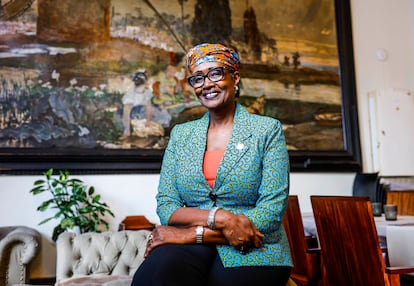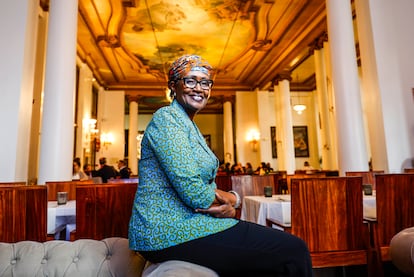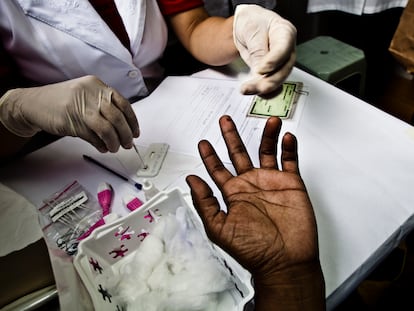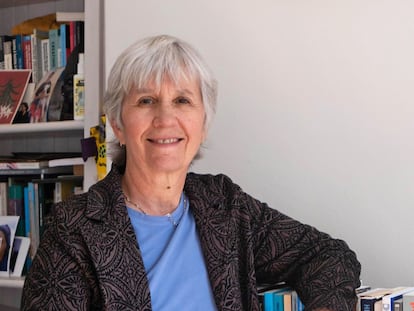Winnie Byanyima, from UNAIDS: ‘Lenacapavir is more effective than condoms or PrEP in prevention’
The executive director of the organization says gender inequality is one of the most important drivers of new infections, especially in Africa


Winnie Byanyima, 65, the executive director of UNAIDS, believes that it is possible that “the AIDS pandemic will cease to be a public health threat by 2030.” To achieve this, lenacapavir — an expensive antiviral drug developed by Gilead, which boasts 100% efficacy in preventing HIV in women and around 96% in men — must become accessible to at-risk populations. Currently, with a price tag exceeding $40,000 per person annually, it remains out of reach.
Byanyima — a staunch advocate for social justice, gender equality, and universal healthcare — recently visited Spain to meet with government officials and civil society representatives. During an interview at the Círculo de Bellas Artes in Madrid, she emphasized that gender inequality is a major driver of new infections: “In many sub-Saharan African countries, three out of four new HIV infections are in girls or young women,” she said.
Q. Do you think lenacapavir will be able to eliminate HIV transmission?
A. It is a transformative tool. It could see us accelerate and actually achieve a sustainable development goal of 2030: ending AIDS as a public health threat.
Q. Why?
A. Because it works for two purposes. One, to treat people with multi-drug-resistant HIV. And two, for prevention, because it has the potential to stop new HIV infections, with 100% efficiency among cisgender women [who identify with the sex assigned at birth], women and men in heterosexual relationships, and transgender people. It is more effective than any other prevention tools that exist, such as condoms or PrEP [pre-exposure prophylaxis, a medication used to reduce the chances of contracting HIV], in preventing AIDS. We cannot forget that last year there were 1.3 million new cases. But, in addition, it has other benefits.
Q. What are they?
A. It’s administered by injection every six months, and that’s essential for people who suffer from HIV stigma and don’t want to be seen swallowing tablets every day [PrEP requires one pill every 24 hours]. This is so important for people who are criminalized, like gay men in some countries, because there is less rise of being recognized if they are taking two doses a year rather than one every day. Or for girls and young women, who also don’t want to be seen swallowing tablets.
Q. But lenacapavir is still very expensive.
A. A course of treatment costs about $44,000 for one person for one year. In countries like Uganda, healthcare costs per person per year are $12, and in some countries, it is as low as $6, so lenacapavir is out of reach. However, a transformative tool is only transformative if people have access to it, and experts say that generic companies could manufacture it at a cost of $44 per person per year. Gilead must continue to be pressured to make it accessible to all who need it.
Q. Gilead has just announced that it will make the drug available to generic manufacturers in 120 countries. How can universal access be guaranteed in the rest?
A. Our challenge is how to make lenacapavir accessible to people around the world who are at risk of contracting HIV. And these people at risk are in low-income countries, but also in middle-income countries. Forty-one percent of new HIV infections are in middle-income countries, and most of them have been excluded from Gilead’s agreement with generic manufacturers. On the other hand, in the 120 countries where Gilead will make the drug available to generic manufacturers, there is a lack of transparency about prices. The company has said that it will supply it on a non-profit basis to six companies. But we still don’t know what its final cost will be in these countries. On the other hand, if a company supplies a drug to 120 countries, it controls the supply.

Q. The recent UNAIDS report highlights that while global HIV infections are declining, they are increasing in 28 countries. What are the main factors driving this trend towards inequality?
A. HIV, like any other pandemic, is driven by inequalities in the enjoyment of human rights. Many people are scared away by the stigma surrounding the disease, so they do not seek prevention or treatment services. This happens a lot in Latin America, which does not have laws criminalizing LGBTQI+ people, but some show up late for treatment, when they are almost dying. The other reason, of course, is criminalization. There are about 60 countries in the world that criminalize LGBTQI+ people, and among them are some of those with the highest rates of HIV infection.
Q. What about gender?
A. Gender inequality is also a major driver of new infections, particularly in Africa. Adolescent girls and young women are infected three times more often than men. In many countries in sub-Saharan Africa, three out of four new infections are in girls or young women. This starts with girls’ lack of access to schools, because many have to drop out of school very early, and we know that schools are the safest place for girls. When a girl stays in school until high school, her risk of contracting HIV is reduced by 50%. When they don’t, they are more likely to fall victim to sexual violence, which is often socially tolerated. That’s why we need to fight sexual violence, but also guarantee girls’ universal and free access to secondary education.
Q. The recent World Health Summit in Berlin devoted a specific space to the search for investments. Is it possible to build solid health systems in countries that spend a large part of their budget on paying off foreign debt?
A. The big issue of inequality is financing. The lowest-income countries have the highest burden of HIV. There are countries drowning in external debt, which are paying four or five times more debt than they spend on health, making it very difficult to finance HIV prevention and treatment. In addition, rich countries also face a myriad of challenges that are taking up their resources, such as other conflicts, climate change adaptation and mitigation policies or migration, which means that development aid is also declining. So we are facing a situation where we could see a reversal of all the progress that has been made against HIV.
Q. How can this be avoided?
A. There is an urgent need for a debt restructuring. That is why I support the call made at the recent Future Summit by the Director-General [Tedros Adhanom Ghebreyesus] of the World Health Organization to start a process of reviewing the whole international financial architecture, both to address the unsustainable debt of developing countries and to improve their access to finance. For example, if a country like Malawi goes to the financial markets to borrow, it gets an interest rate eight times higher than other countries like Germany.
Q. Do you think that if WHO member states manage to agree on the Pandemic Treaty, the agreement will contribute to combating HIV?
A. Absolutely. We lost an opportunity to address inequalities in the global economic system during Covid. The next pandemic is coming, it’s just a matter of time. Do we want to repeat what we experienced with Covid, with millions of people dead and economies in ruins? That’s why a binding agreement on isolating the pathogen, developing vaccines, making the technology universally accessible and building capacity in each region to produce diagnostic systems, therapies, and vaccines, is so important.
Sign up for our weekly newsletter to get more English-language news coverage from EL PAÍS USA Edition
Tu suscripción se está usando en otro dispositivo
¿Quieres añadir otro usuario a tu suscripción?
Si continúas leyendo en este dispositivo, no se podrá leer en el otro.
FlechaTu suscripción se está usando en otro dispositivo y solo puedes acceder a EL PAÍS desde un dispositivo a la vez.
Si quieres compartir tu cuenta, cambia tu suscripción a la modalidad Premium, así podrás añadir otro usuario. Cada uno accederá con su propia cuenta de email, lo que os permitirá personalizar vuestra experiencia en EL PAÍS.
¿Tienes una suscripción de empresa? Accede aquí para contratar más cuentas.
En el caso de no saber quién está usando tu cuenta, te recomendamos cambiar tu contraseña aquí.
Si decides continuar compartiendo tu cuenta, este mensaje se mostrará en tu dispositivo y en el de la otra persona que está usando tu cuenta de forma indefinida, afectando a tu experiencia de lectura. Puedes consultar aquí los términos y condiciones de la suscripción digital.
More information
Archived In
Últimas noticias
Welcome to the post-religion era: The idea of Christianity as the absolute truth has become obsolete
‘I thought you would like it’: The risky sexual practice popularized by TV shows and TikTok
The digitalization of tourism: ‘They promise experiences and gave us the worst possible one’
Mexican peso defies uncertainty with forecasts of a new period of stability in 2026
Most viewed
- Sinaloa Cartel war is taking its toll on Los Chapitos
- Oona Chaplin: ‘I told James Cameron that I was living in a treehouse and starting a permaculture project with a friend’
- Reinhard Genzel, Nobel laureate in physics: ‘One-minute videos will never give you the truth’
- Why the price of coffee has skyrocketed: from Brazilian plantations to specialty coffee houses
- Silver prices are going crazy: This is what’s fueling the rally










































